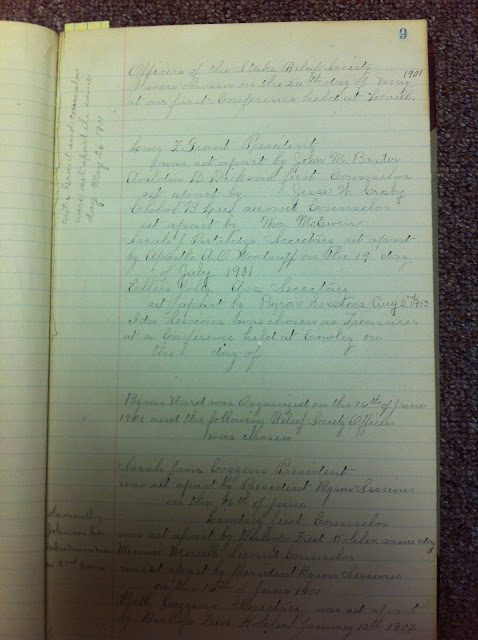Last summer while traveling through Wyoming, our family stopped off the main highway to see the wagon ruts left by pioneers on the Oregon/Mormon/California Trail. This in the South Pass area, where all of these trails converged.
 |
| Here you can see the wagon ruts off to the side of the dirt road; the road is also part of the trail, I believe, but it's been modified for modern vehicles |
The directions on how to get here are pretty funny:
"From South Pass Rest Area, continue south on Wyoming Highway 28 for 0.7 mile, watching on the right for a sign indicating the Big Sandy entrance to the Bridger Wilderness. Do not follow the sign, but instead continue another 0.2 mile on the highway and turn left (southeast) onto Oregon Buttes Road, Fremont County 445, a well-maintained dirt road. Zero your trip odometer, then continue southeast across the cattle guard and under the power lines.
Cross a second cattle guard and continue to odometer reading 2.8 miles, slowing where the road begins curving to the right. Look for the old wagon trail crossing Oregon Buttes Road at the curve; it can be hard to see when approaching from the north. Turn right (west) onto the two-track. If the two- track appears too rough for your vehicle, park here and hike about three-fourths of a mile to the South Pass monuments."
Here's a link so you can see the directions yourself. I mean, seriously, if you're following directions that tell you to cross a cattle guard and go under the power lines, it's getting serious. This isn't a casual pull over to the side of the highway to read an historical monument without getting out of your car. Oh, no! This is an adventure! If you're following directions like this, you also are probably in Wyoming, with its huge swaths of open country with no roads and hardly any civilization. It is incredible. You could get out of your car, pretend it isn't there, and look all around you. This is what the land was like for the pioneers, crossing this land by the hundreds over a twenty year period (late 1840s-1869).
The directions are above are from
Wyohistory.org, which is a fabulous website with tons of great Wyoming history and information on historic sites. Which you probably care about, even if you don't yet realize it. I am originally from Wyoming, so I may be biased, but I think everyone should be interested in Wyoming history--at least the history of South Pass and the areas crossed by settlers coming to the American West. Mormon history, for example, and Wyoming history cross paths. The tragedy of the Martin & Willie Handcart companies took place in Wyoming; it is Wyoming history and Mormon history. Historian Will Bagley wrote a great article on wyohistory.org about the importance of South Pass. He writes:
"the discovery of a direct land route across the Continental Divide with a relatively easy grade was a godsend to those who hoped to see the United States of America stretch from the Atlantic to the Pacific. Without South Pass, it is almost certain that the Pacific Northwest would have been permanently claimed by the British and the southern part of the continent would have remained part of Mexico. South Pass, the isolated little saddle that straddles the Continental Divide in the midst of Wyoming, still the least populated state in the nation, truly provided the key to today's United States. - See more at: South Pass, by Will Bagley
South Pass is important! And beautiful. Look at that sky!
 |
| This is looking west, I think. |
In the directions linked above, it tells you to continue on this dirt road to see some historical markers, if you think your vehicle could handle it. If not, you can hike 3/4 of a mile to see the markers.
Well. We made this detour in the middle of an 8 hour drive in a van filled with 8 grumpy kids. I was the only one who wanted to see the wagon ruts. There was no way anyone would hike with me, or be willing to wait for me to hike myself. No one even wanted to get out of the van to see these ruts.
It makes me sad now, that we were this close and didn't continue on to see the rest of the markers. I need to prepare my family better; we are going to stop at historic sites! That's got to be figured into the travel time. Next time (and there will definitely be a next time, as this is on the road to Grandma's house), we will continue on!
Here is the marker we did see at the place we drove to. It was a little difficult for me to tell which buttes were which (Oregon or Pacific) because they didn't seem to match the picture on the marker here.
Actually, I think that this must be Oregon Buttes in the distance in this this picture. The landmark in the background on the left side of the picture. It does seem to match the picture on the monument, and it was taken looking south.
When we (my husband & I) were out of our vehicle looking at the wagon ruts and the Oregon Buttes marker, there were bugs everywhere. Like horse flies and mosquitoes. So if you want to hike to the other markers, you might want to be prepared with bug spray, long sleeves, and pants.
There are historic markers off the main highway in this area, too, at the Southpass Overlook. I've been there, but I haven't taken pictures. It is a pretty view and worth seeing.
This is a link to a pamphlet put out by the National Parks Service on the Auto Tour Route of Historic Trails across Wyoming:
http://www.nps.gov/oreg/planyourvisit/upload/WY_ATRIG_Web_OR.pdf
















